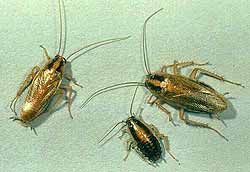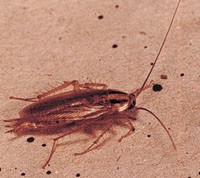Identification: The German cockroach is found widely throughout Europe. It prefers warm, moist environments, especially heating systems in large buildings, bakeries etc. German cockroaches can swim and will climb smooth surfaces easily. Once established the insect is often difficult to eradicate due to it hiding in inaccessible places.The German cockroach is 12-15mm, mid brown, with a yellow brown thorax having two dark brown stripes and long antennae. It is capable of flying but does not do so readily. The wings are full length in the male but 2/3 length in the female.The mated female cockroach produces an egg-containing structure called an ootheca, which can contain up to 30-40 eggs. The eggs develop for 2-4 weeks, dependant upon temperature, and hatch as nymphs, which are initially pure white but turn brown rapidly. These undergo a number of skin moults, growing larger each time and the adult cockroach emerges from the final nymphal stage 3-6 months later. Adult cockroaches are not active during the day but forage for food and water at night. They scavenge for any form of organic material, including human waste. As they need water they normally hide during the day in the vicinity of taps, sinks, drains and other water sources.The German cockroach can and does carry and spread diseases and when found should be tackled as soon as possible.Before carrying out any treatment it is necessary to establish the extent of the infestation. Inspection at night, flushing with aerosol insecticidal sprays and the use of sticky traps are particularly useful in determining the size of the infestation.
Control: There are a number of options available to treat for cockroaches, including dusts, baits and sprays. Any of these, if used, should be in conjunction with improved hygiene, especially removal of food wastes and general cleaning.
Cockroaches




